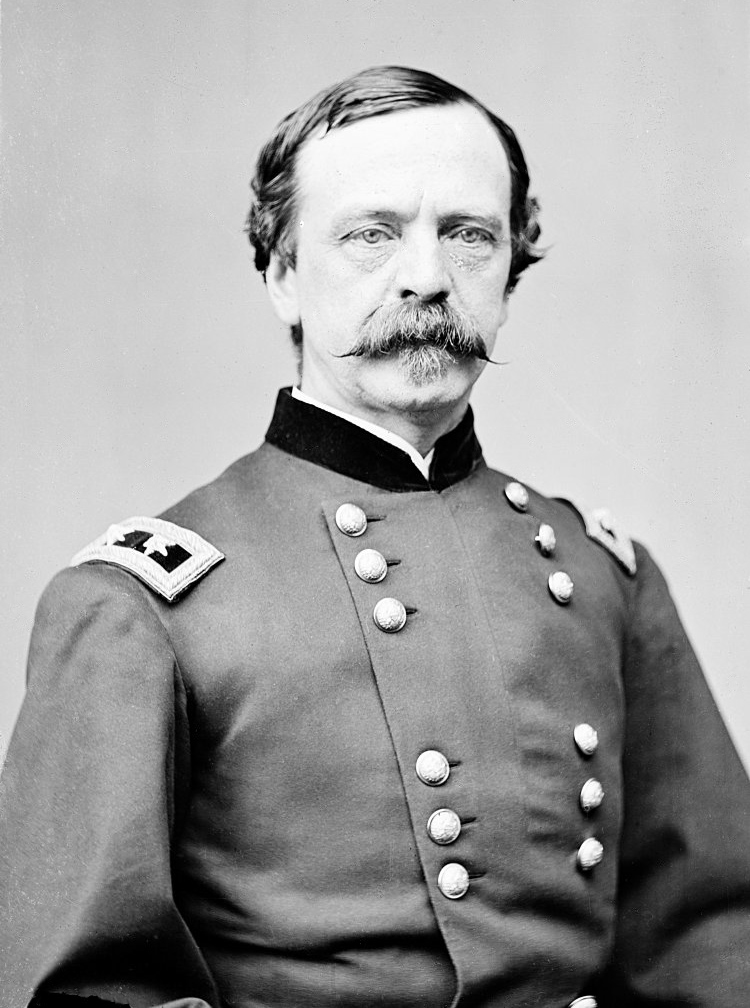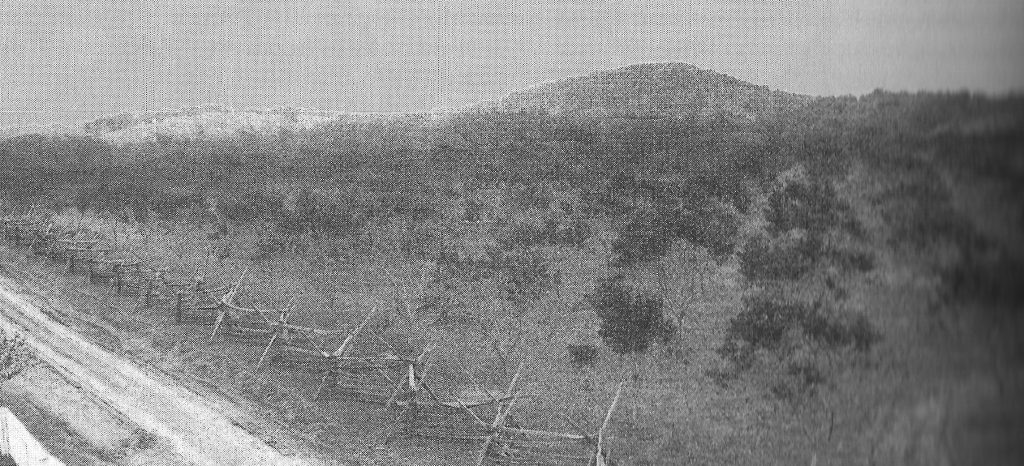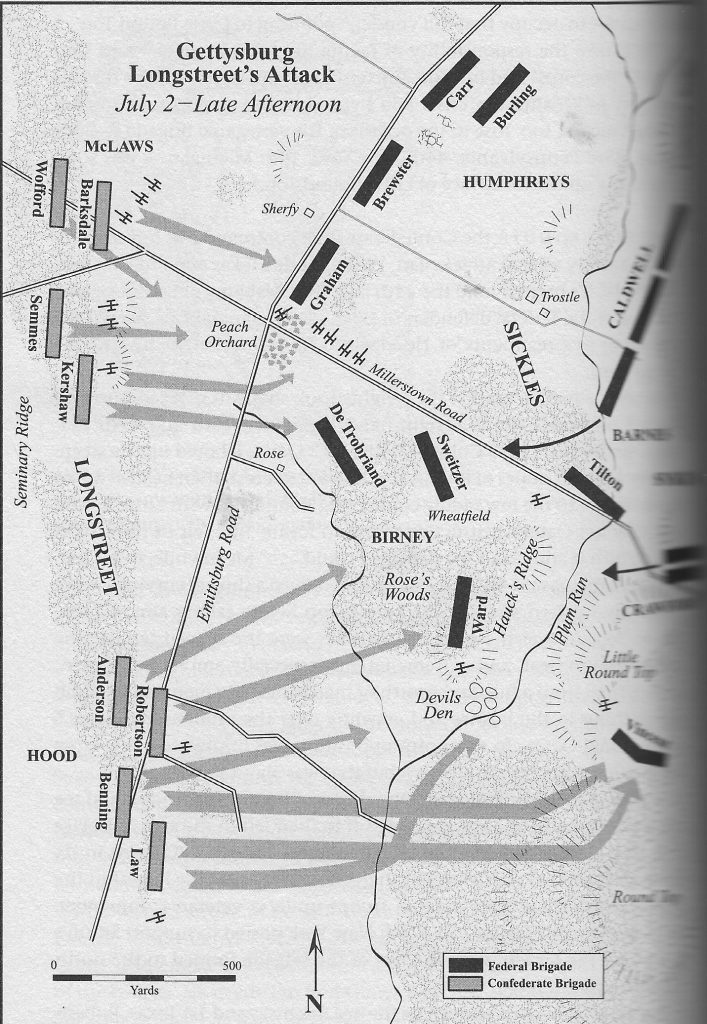
As MG Sickles made his way to Gettysburg in the late morning of Day 1, he came via the Emmittsburg Road. This took him past a prominent terrain feature, a knoll topped by an orchard. He had a flash-back to Hazel Grove at Chancellorsville [see Section 1d]. He then rode on to find the Union HQ. There he met with LTG Hancock and tried to make himself useful but truthfully Hancock had no use for him in more ways than one.

In the wee hours of the morning, he learned that Meade had assigned his Third Corps to extend the Union line south from the right flank of Hancock’s Second Corps. He moved his command staff to the low area (the Saddle) between Cemetery Ridge and Little Round Top. As his two divisions arrived, he had them bed down on the reverse slope. They had had a very long day’s march and he saw no reason why they should be immediately concerned with strengthening their position.
There are a number of different accounts as to precisely what transpired between Sickles and his staff and Meade and his staff. Suffice it to say that Sickles was dis-satisfied with the terrain he had been assigned to defend. Sickles seems to have become obsessed with that knoll looming a few hundred yards in front of his position. Like Hazel Grove, he viewed it as an ideal artillery platform that could easily lay waste to his position on and around LRT. He even took BG Hunt, Meade’s Artillery Chief on a scouting ride over to that orchard. Hunt agreed that it was an ideal artillery pointing either way. Whether or not Sickles had a direct conversation with Meade or (more likely) only with Meade’s staff, Sickles came away from Meade’s HQ convinced that he had permission to deploy his Corps as he saw fit south of Second Corps.
First he ordered a reconnaissance in force. He sent an entire brigade of Humphrey’s division over to that knoll. They continued beyond it, across the sunken roadbed and up onto Seminary Ridge. There they encountered the vanguard of Anderson’s division of Hill’s Corps that was moving into position on the east-facing slope of that ridge. Sickles took this brief encounter as proof that soon the Rebel artillery would be in that orchard. Certainly without a direct order to do so, and possibly without permission at all, Sickles moved his two divisions off of LRT.

He placed Humphrey’s Division in the Peach Orchard and Birney’s facing southwest in the area in front of LRT. His left flank was at Devil’s Den and his right spanned a wheat field. Sickles had too few men to guard the gap that now existed between his divisions. He filled that gap with every cannon he could muster, but with no infantry to screen for them. In addition, there was now a gap of some 750 yards from the orchard back to Hancock’s left flank. Some of the officers there were left scratching their heads as they watched regiment after regiment shift westward leaving their left flank completely exposed. Sickles established his HQ at a central location at the Trostle farm.
Part 2: WHY SOUTH?
At the risk of adding a bit of confusion and jumping ahead to Alternative History, I’m going to interject a question at this point in the series: WHY did MG Sickles deploy Birney’s Division to the south rather than the north?
When, in the late morning, Sickles sent out his recon in force, the only Rebel troops they encountered were on the east-facing slopes of Seminary Ridge. He would later learn that these were part of Anderson’s Division that was just moving into that position. But when he made his bold shift west, he sent Humphrey’s Division to occupy the knoll containing the orchard and he positioned Birney facing south.
Since the only Rebel force was off to his NW, WHY did he feel the need to have Birney on the left (southern) flank as opposed to the north? Between Humphrey and Hancock’s line on the southern end of Cemetery Ridge, there was more than a half-mile gap. This was a considerable vulnerability. Surprisingly, when Anderson attacked in the early evening of Day 2, he targeted Hancock’s main defensive line and never seemed to recognize that undefended gap. It is possible, however, that by the time of his attack, that area was a busy place. GEN Meade had been funneling in troops to bolster Sickles and many of them would likely have transited that area using the saddle between the two ridges as their entry point. Never the less, none of those units seemed to be defending the gap per se. It might have allowed Rebel troops to encircle Humphrey from behind or from his right flank. Yet, no Rebel troops seemed to recognize much less exploit this gap.
Returning to the decision to place Birney facing south: WHAT was Sickles aligning him against? Although the timing is not certain, we do know that Longstreet had dispatched his artillery under Alexander to set up just to the south of Seminary Ridge to support his planned attack up the Emmittsburg Road. Those were the only possible troops to the south. Had Sickles noted their presence and recognized them as a threat? Was he truly astute enough to anticipate that where there was artillery, there would soon be infantry? But since he would likely have been quite busy directing his two divisions’ movements, would he likely have even been aware of Alexander’s approach? Alexander seemed to think that he had established his position in the wooded area to the south without drawing the attention of the Union signal unit on Little Round Top.
Somewhat later, as BG Warren stood on LTR, his attention seemed to be drawn to Hood’s infantry moving into position to the south. Was he even aware of the nearby artillery hidden in the trees?
Obviously, there was a reason that Sickles sought to defend his left flank and not his right. He obviously made the correct choice. Had he defended the gap between Humphrey and Hancock, Hood’s flanking movement would have likely been able to hit him – and possibly even the orchard – from the rear, wreaking havoc.
Again, I state that I tend to look at the elements of this battle from the viewpoint of a bird or drone positioned above the action. It simply seems unnatural to me that given what he knew about Rebel forces, Sickles would have been more concerned with defending his left flank than his right.
